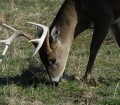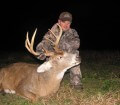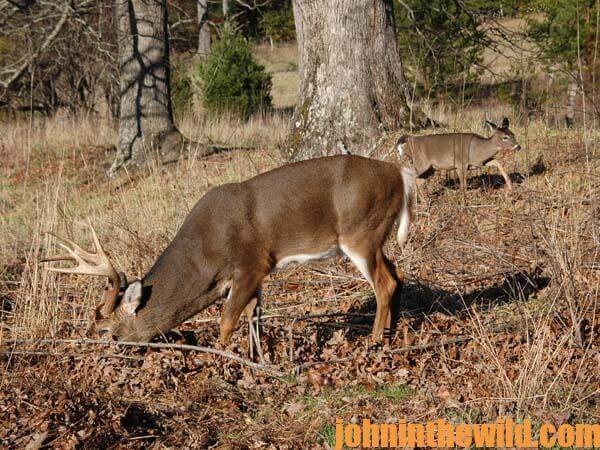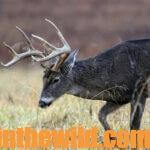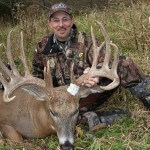John’s Note: The easiest way to bag a buck, which may eat 5-9 pounds of 300+ foods per day, is through his stomach. Learn which foods are what deer like best and also when and why they eat.
When we look more closely at why I was able to bag three bucks under the same white oak tree (see Day 1), we have to understand why the deer continued to show up in this particular place. First of all, the white oak at the time I was hunting was a preferred food source of the deer, which browse and eat all kinds of grasses, nuts, fruits and sometimes the leaves, twigs and buds of woody plants like trees, shrubs and vines. Dr. Keith Causey, a retired professor of wildlife science at Alabama’s Auburn University, explains that, “Deer will pick up and nibble and eat almost everything in the forest. But there are some foods that feel better in their mouths or taste better to them. The deer will take the choice parts of a plant maybe 1 month out of the year and ignore that plant the other 11 months. So, in any given area, deer may have a half dozen different foods that they tend to feed on more than they do other foods. For instance, deer in my part of the country have certain types of seedlings they choose over others. They like oak seedlings and the ash group of trees better than they do hickory or pine seedlings. Also there are seasonal preferences for foods like muscadines, persimmons and other fruits that occur once a year.”
 The deer’s preferred foods are much like the dessert part of his meal. And, many times the deer will walk a considerable distance to find that dessert. However, even when you know what the chosen food of the deer is during the time you plan to hunt, you can’t necessarily concentrate the animals close enough to your stand to take a shot. To hunt over a preferred food source, that food has to be in short supply in the specific region where you are hunting.
The deer’s preferred foods are much like the dessert part of his meal. And, many times the deer will walk a considerable distance to find that dessert. However, even when you know what the chosen food of the deer is during the time you plan to hunt, you can’t necessarily concentrate the animals close enough to your stand to take a shot. To hunt over a preferred food source, that food has to be in short supply in the specific region where you are hunting.
For instance, the white oak tree that I hunted (see Day 1) was the only white oak within 1- to 1-1/2-miles. Most of the deer where I was hunting came to that tree to get the white oak acorns during the time that the tree was dropping those acorns. When the acorns ceased to fall, the deer quit coming to the tree. So, not only does a woodsman have to locate a preferred food source during the time he plans to hunt, but that food source must be in relatively-short supply and draw deer to it from a fair-sized geographical region.
Besides a deer’s preferred food changing during a year’s time, the favorite food in one region for a certain group of deer may not be the preferred food in another area for another group of deer. One elderly deer hunter told me, “On the west side of the state during the early fall, the deer prefer white oak acorns and turn their noses up at the red oaks, while on the other side of the state, the deer like the red oak acorns best.”
In many parts of the North, the deer’s preferred food during hunting season may be apples in an apple orchard. Yet in other sections of the country where apples are few and far between, the deer may select sumac or soybeans instead of apples.
 Autumn is a critical time for deer to add body fat to sustain them through the winter. During the fall and winter, deer prefer:
Autumn is a critical time for deer to add body fat to sustain them through the winter. During the fall and winter, deer prefer:
* Fall Woody Plants: oaks, black gums, hawthorns, greenbrier, jessamine, French mulberry, blackberry, rose and honeysuckle.
* Fall Forbs: composites, pussy’s toes, wild lettuce, beggar’s lice, bellflower and pokeweed.
* Fall Fruits: persimmons, muscadines, grapes, pokeweed berries, apples, black gum and dogwoods.
* Fall Nuts: acorns, hickory nuts and beechnuts.
* Winter Wood Plants: dogwood, blueberry, strawberry bush, honeysuckle, black gum, privet, jessamine, sassafras, willow, sumac, red cedar and oaks.
* Winter Forbes: sedges and pussy’s toes.
* Winter Fruits: coralberry and sumac seedheads.
So how does a hunter know what foods he can concentrate the deer around? We’ll learn tomorrow.
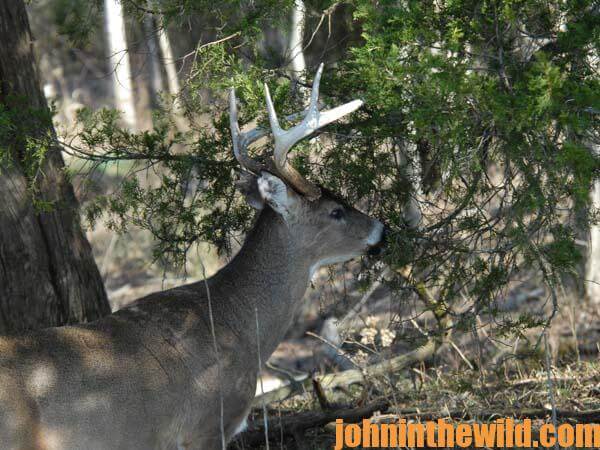 To get John E. Phillips’ eBooks and print books on hunting deer, “How to Hunt and Take Big Buck Deer on Small Properties,” “How to Hunt Deer Up Close: With Bows, Rifles, Muzzleloaders and Crossbows,” “PhD Whitetails: How to Hunt and Take the Smartest Deer on Any Property,” “How to Take Monster Bucks,” “How to Hunt Deer Like a Pro,” and “Bowhunting Deer: Mossy Oak Pros Know Bucks and Bows,” or to prepare venison, “Deer & Fixings,” click here on each.
To get John E. Phillips’ eBooks and print books on hunting deer, “How to Hunt and Take Big Buck Deer on Small Properties,” “How to Hunt Deer Up Close: With Bows, Rifles, Muzzleloaders and Crossbows,” “PhD Whitetails: How to Hunt and Take the Smartest Deer on Any Property,” “How to Take Monster Bucks,” “How to Hunt Deer Like a Pro,” and “Bowhunting Deer: Mossy Oak Pros Know Bucks and Bows,” or to prepare venison, “Deer & Fixings,” click here on each.
For information on making jerky from your deer to provide a protein-rich snack, you can download a free book from https://johninthewild.com/free-books.

